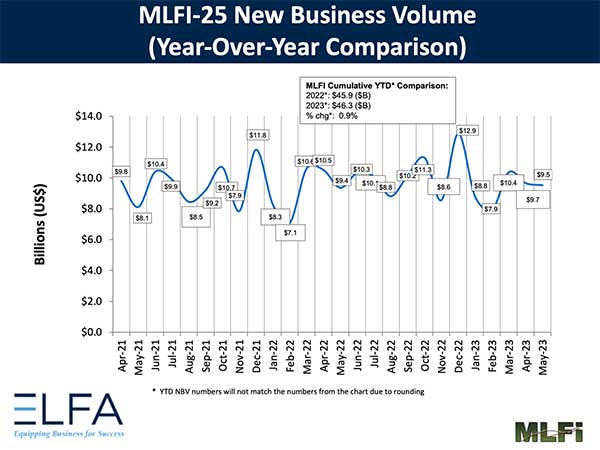May new business volume of surveyed member companies was up 1% year-over-year.

Washington, DC—The Equipment Leasing and Finance Association’s (ELFA) Monthly Leasing and Finance Index (MLFI-25), which reports economic activity from 25 companies representing a cross section of the $1 trillion equipment finance sector, showed their overall new business volume for May was $9.5 billion, up 1 percent year-over-year from new business volume in May 2022. Volume was down 2 percent from $9.7 billion in April. Year-to-date, cumulative new business volume was up 0.9 percent compared to 2022.
Receivables over 30 days were 2.0 percent, up from 1.8 percent the previous month and up from 1.6 percent in the same period in 2022. Charge-offs were 0.33 percent, unchanged from the previous month and up from 0.12 percent in the year-earlier period.
Credit approvals totaled 76.4 percent, down from 77.3 percent in April. Total headcount for equipment finance companies was down 2.5 percent year-over-year.
Separately, the Equipment Leasing & Finance Foundation’s Monthly Confidence Index (MCI-EFI) in June is 44.1 an increase from the May index of 40.6.
ELFA President and CEO Ralph Petta said, “MLFI respondents show steady new business volume for the month of May. As the Fed puts a pause on interest rate hikes and the U.S. economy refuses to accede to a recession—at least for the time being—equipment finance companies continue to do what they do best, i.e., provide the necessary capital for businesses to grow and prosper. A number of equipment finance executives polled recently have expressed a sense of heightened optimism that the industry will continue to show steady growth, at least in the near term.”
Daryn Lecy, Vice President and Chief Operating Officer, Oakmont Capital Services, said, “We are cautiously optimistic about the stability of the economy based on both the recent indicators and what continues to be resilient demand from businesses. The tightened liquidity remains a concern, but we have seen some small signs of localized stabilization with previously shy banks and finance companies slowly showing interest in exploring equipment finance assets. Our industry provides great support during these times by continuously thinking creatively, remaining nimble, and finding niches and opportunities as they arise.”
About ELFA’s MLFI-25
The MLFI-25 is the only near-real-time index that reflects capex, or the volume of commercial equipment financed in the U.S. The MLFI-25 is released globally at 8 a.m. Eastern time from Washington, D.C., each month on the day before the U.S. Department of Commerce releases the durable goods report. The MLFI-25 is a financial indicator that complements the durable goods report and other economic indexes, including the Institute for Supply Management Index, which reports economic activity in the manufacturing sector. Together with the MLFI-25 these reports provide a complete view of the status of productive assets in the U.S. economy: equipment produced, acquired and financed.
The MLFI-25 is a time series that reflects two years of business activity for the 25 companies currently participating in the survey. The latest MLFI-25, including methodology and participants, is available at www.elfaonline.org/knowledge-hub/mlfi-25-monthly-leasing-and-finance-index.
The MLFI-25 is part of the Knowledge Hub, the source for business intelligence in the equipment finance industry. Visit the hub at www.elfaonline.org/KnowledgeHub.
MLFI-25 Methodology
ELFA produces the MLFI-25 survey to help member organizations achieve competitive advantage by providing them with leading-edge research and benchmarking information to support strategic business decision making.
The MLFI-25 is a barometer of the trends in U.S. capital equipment investment. Five components are included in the survey: new business volume (originations), aging of receivables, charge-offs, credit approval ratios, (approved vs. submitted) and headcount for the equipment finance business.
The MLFI-25 measures monthly commercial equipment lease and loan activity as reported by participating ELFA member equipment finance companies representing a cross section of the equipment finance sector, including small ticket, middle-market, large ticket, bank, captive and independent leasing and finance companies. Based on hard survey data, the responses mirror the economic activity of the broader equipment finance sector and current business conditions nationally.
About ELFA
The Equipment Leasing and Finance Association (ELFA) is the trade association that represents companies in the $1 trillion equipment finance sector, which includes financial services companies and manufacturers engaged in financing capital goods. ELFA members are the driving force behind the growth in the commercial equipment finance market and contribute to capital formation in the U.S. and abroad. Its 580 members include independent and captive leasing and finance companies, banks, financial services corporations, broker/packagers and investment banks, as well as manufacturers and service providers. ELFA has been equipping business for success for more than 60 years. For more information, please visit www.elfaonline.org.
Follow ELFA:
Twitter: @ELFAonline
LinkedIn: https://www.linkedin.com/groups/89692/
ELFA is the premier source for statistics and analyses concerning the equipment finance sector. Please visit www.elfaonline.org/knowledge-hub/knowledge-hub-home for additional information.
Media/Press Contact: Amy Vogt, Vice President, Communications and Marketing, ELFA, 202-238-3438 or avogt@elfaonline.org
In this episode, I sat down with Beejan Giga, Director | Partner and Caleb Emerson, Senior Results Manager at Carpedia International. We discussed the insights behind their recent Industry Today article, “Thinking Three Moves Ahead” and together we explored how manufacturers can plan more strategically, align with their suppliers, and build the operational discipline needed to support intentional, sustainable growth. It was a conversation packed with practical perspectives on navigating a fast-changing industry landscape.